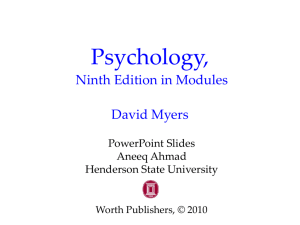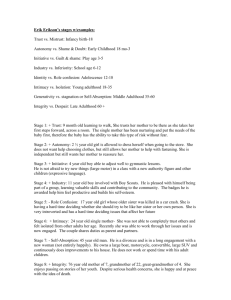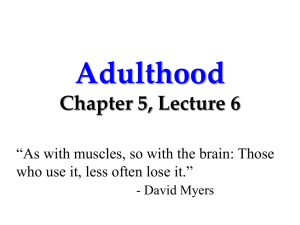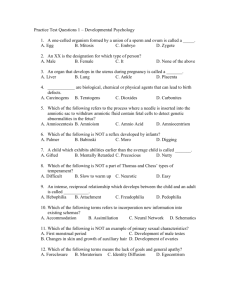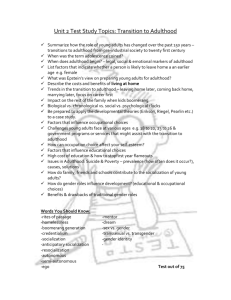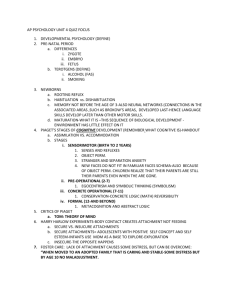LSChap10SlidesPost
advertisement
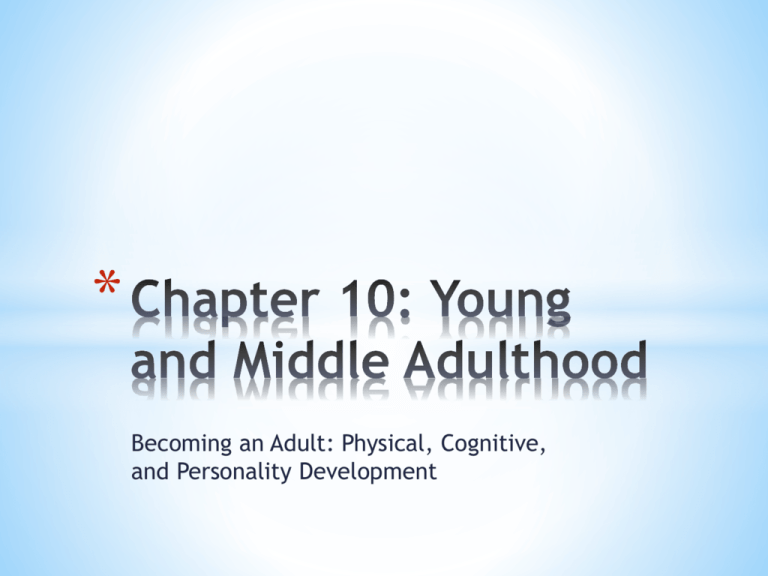
* Becoming an Adult: Physical, Cognitive, and Personality Development * What role transitions mark entry into adulthood in Western societies? How do nonWestern cultures mark the transitions to adulthood? * How does going to college fit in the transition to adulthood? * What psychological criteria mark the transition to adulthood? * What aspects of early young adulthood make it a separate developmental stage? * *Period between late teens and mid-to late twenties when individuals are not adolescents but are not yet fully adults * *Role Transitions - the process of assuming new responsibilities and duties * E.g., (Western Culture) voting, completing education, full-time employment, establishing an independent household, getting marries, parenthood *Rites of Passage - rituals marking initiation into adulthood * E.g., tribal rituals * * 67% of all high-school graduates go to college * Promotes intellectual and personal growth * Returning Adult Students - college students over 25 * Tend to be: problem solvers, self-directed, pragmatic * Integrate coursework with employment * * Establishing Intimacy * Intimacy versus Isolation - sixth stage in Erikson’s theory and the major psychosocial task for young adults * Stronger sense of identity correlated to higher levels of intimacy in young adults * * In what respects are young adults at their physical peak? * How healthy are young adults in general? * How do smoking, drinking alcohol, and nutrition affect young adults’ health? * How does the health of young adults differ as a function of socioeconomic status, gender, and ethnicity? * * Physical functioning generally peaks during young adulthood * Overall young adults are healthy * Fewer deaths from disease * * Smoking * More than half of the cancers are related to smoking (American Cancer Society) * Risks with second-hand smoke * Drinking Alcohol * Binge drinking: type of drinking defined for men as consuming five or more drinks in a row and for women as consuming four or more drinks in a row within the past 2 weeks * Addiction: physical dependence on a substance such that withdrawal symptoms are experienced when deprived of that substance * *Nutrition * Metabolism: how much energy the body needs * Low-density lipoproteins (LDLs): chemicals that cause fatty deposits to accumulate in arteries, impeding blood flow * High-density lipoproteins (HDLs): chemicals that help keep arteries clear and break down LDLS * Body mass index (BMI): a ratio of body weight and height and is related to total body fat *Social Factors * Socioeconomic status - ability to acquire adequate health care * Education - association with higher income; higher awareness of dietary and lifestyle influences on health *Gender * Women live longer than men on average; young men are more likely to die from homicide *Ethnic Group Differences * Relationship between ethnicity and SES * * What is intelligence in adulthood? * What types of abilities have been identified? How do they change? * What is postformal thought? How does it differ from formal operations? * How do stereotypes influence thinking? * *How should we view intelligence in adults? * Multidemensional - characteristic of theories of intelligence that identify several types of intellectual abilities * Multidirectionality - developmental pattern in which some aspects of intelligence improve and other aspects decline during adulthood * Interindividual Variability - patterns of change that vary from one person to another * Plasticity - concept that intellectual abilities are not fixed by can be modified under the right conditions at just about under point in adulthood * *Primary Abilities - groups of related intellectual skills (e.g., memory, spatial ability) * * Secondary Abilities - broader intellectual skills that subsume and organize the primary abilities * Fluid Intelligence - abilities that make you a flexible and adaptive thinker, allow you to make inferences and to understand the relations among concepts * Crystallized Intelligence - the knowledge you acquired through life experience and education in a particular culture * Postformal Thought - thinking characterized by recognizing that the correct answer varies from one situation to another, that solutions should be realistic, that ambiguity and contradiction are typical, and that subjective factors play role in thinking * Reflective Judgment - way in which adults reason through real-life dilemmas * * Optimal Level of Development - the higher level of information-processing of which a person is capable * Skill Acquisition - the gradual and haphazard process by which people learn new abilities * Integrating Emotion and Logic in Life Problems * * Stereotype - a social belief representing organized prior knowledge about a group of people that affects how we interpret new information * Implicit Stereotype - activation of strong stereotypes that is nonconscious, increasing the likelihood of their influencing behavior * Stereotype Threat - an evoked fear of being judges in accordance with a negative stereotype about a group to which you belong * * What is the life-span construct? How do adults create scenarios and life stories? * What are possible selves? Do they show differences during adulthood? * What are personal control beliefs? * * Life-Span Construct - a unified sense of the past, present, and future based on personal experience and input from other people * Scenario - manifestation of the life-span construct through expectations about the future * Social Clock - tagging future events with a particular time or age by which they are to be completed * *McAdam’s Life Story Model * A personal narrative that organizes past events into a coherent sequence * Representations of what we could become, what we would like to become, and what we are afraid of becoming * * The degree to which you believe your performance in a situation depends on something you do *


